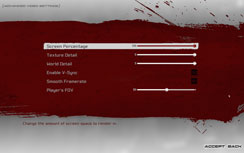Unreal Tournament 3
Publisher: MidwayUnreal Tournament 3 is the latest addition to the Unreal franchise and it is a clear attempt to replace the previously separate games. Unreal used to be very focused on singleplayer elements, while Unreal Tournament's focus was on the multiplayer side of things.
The game is based on Epic's heavily licensed Unreal Engine 3 technology, which is used by many games that were released last year or are due for release over the next couple of years. The current version of Unreal Tournament 3 only supports DirectX 9.0 but Mark Rein, vice president of Epic Games, said that DirectX 10 support in UT3 is forthcoming.
The engine uses a Deferred Rendering technique, which basically prevents the game from supporting anti-aliasing techniques in a traditional sense because there are multiple surfaces stored in the MRTs. In fact, Epic decided that there wasn't even a need to include application-controlled anisotropic filtering - instead, we had to force anisotropic filtering from the driver control panel.
Because of the variability in this title, being a multiplayer game, we played five three minute bot matches against 23 bots on the vCTF-Sandstorm map, recording the average frame rate over this period. We then removed the highest and lowest results to remove outliers and the average of the remaining three is the frame rate we are displaying here -- this represents around nine minutes of typical gameplay.
After we completed our testing for this review, it was made known to us that ATI, like Nvidia, has now enabled support for anti-aliasing in this title using a driver workaround. We'll come back to testing anti-aliasing performance in this title at a later date.
With UT3 being a multiplayer game, the higher average frame rates are more of an issue for most gamers than they will be in BioShock. The story is pretty similar in many respects though, being based on the same engine, but this time the Radeon HD 3870 X2 establishes its performance leadership very early on.
The more expensive GeForce 8800 Ultra manages to stay within touching distance of the Radeon HD 3870 X2 at 1680x1050 and 1920x1200. Once again though, the 3870 X2 stretches its legs at 2560x1600, where it establishes leads of 18 percent and 26 percent over the GeForce 8800 Ultra and GeForce 8800 GTX respectively.

MSI MPG Velox 100R Chassis Review
October 14 2021 | 15:04











Want to comment? Please log in.